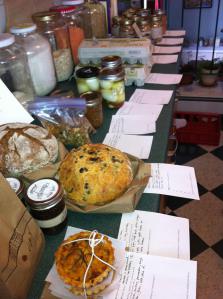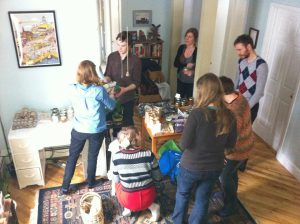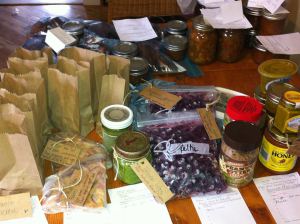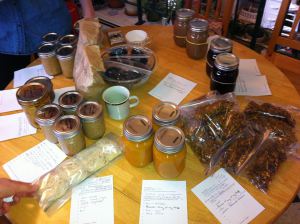 Food swapping. It’s a thing. A really exciting, fast paced, delicious thing that all food lovers can surely get behind. Whether you’re trying to conquer that kitchen creativity rut, revive an old favorite recipe, or just looking for an excuse to get together and talk and eat with other food enthusiasts, a food swap may just be for you.
Food swapping. It’s a thing. A really exciting, fast paced, delicious thing that all food lovers can surely get behind. Whether you’re trying to conquer that kitchen creativity rut, revive an old favorite recipe, or just looking for an excuse to get together and talk and eat with other food enthusiasts, a food swap may just be for you.
I won’t try to identify the origins of a ‘food swap’. In my mind, food swaps have been happening in many forms for a long time. I’ve been pulling weeds in my community garden on numerous occasions when a fellow gardener has offered me their excess of zucchini and in return I have offered my overflow of mizuna or kale. Impromptu trades like these are not novel, but they are rewarding. Scale them up a bit—throw-in some added product value, and involve more people—and you’ve got your very own food swap.
Back in August, the EAC and Rustik Magazine hosted Kate Payne to talk with Haligonians about food swaps and how to make them happen here. Kate is the author of the awesome blog, The Hip Girl’s Guide to Homemaking, and is a big enthusiast for urban homesteading and self-sufficient living. She encourages people to gather and share their knowledge, skills, and delicious kitchen creations as a way to build and inspire strong communities. Since her talk I have heard of several food swaps happening around Halifax, and it seems to me a wave is building.
After attending two food swaps hosted by friends, we (me and a friend, Aimee Carson) decided to host our own. We could plainly see that they were ridiculously easy to organize, and for food lovers like us, so much fun to take part in. So why not? Honestly and truly, it was a smashing success, and all it took was a bit of organization, some cooking, and a decent square footage of counter space.
A food swap works like this: guests arrive and are given a piece of paper where they write their name, their food item, and the main ingredients. We call this the ‘swap sheet’. They find a place on the ‘swap table’ to display their goods to trade. If they have samples of their goods, they can set them up on a separate ‘tasting table.’ In the beginning people mingle, get to know each other, sample foods available for trading, and write their names beside food they’re interested in trading for. Nobody is held to the list! Once official trading time is announced, it starts to get wild (I’m almost joking about this) while people rush around to make the best trades. I’m sure a spectator would think it is madness (think ‘trading floor of the NYSE’), but to the swappers its pure foodie bliss, not to mention an adrenalin rush!
 We invited about twenty people and ended up with twelve keen swappers. Most people brought several different items, giving us a quite a variety of trading goods. Swaps with as few as five or six can work well, you just don’t get as much selection and no matter how many, it’s good to encourage swappers to bring multiple items. Packaging is up to individual swappers, but it’s important to label ingredients so people know what they’re getting. Depending on your numbers and audience, you may want to hold your food swap in a public place such as a community center or church hall- just make sure you have enough space for your intended numbers! We had a couple of counter tops, a desk, and two decent sized tables, and we used every inch of available flat surfaces.
We invited about twenty people and ended up with twelve keen swappers. Most people brought several different items, giving us a quite a variety of trading goods. Swaps with as few as five or six can work well, you just don’t get as much selection and no matter how many, it’s good to encourage swappers to bring multiple items. Packaging is up to individual swappers, but it’s important to label ingredients so people know what they’re getting. Depending on your numbers and audience, you may want to hold your food swap in a public place such as a community center or church hall- just make sure you have enough space for your intended numbers! We had a couple of counter tops, a desk, and two decent sized tables, and we used every inch of available flat surfaces.
During Kate’s talk she gave a lot of examples of how food swaps work in different places, and there are any number of ways that a food swap could go. Getting ideas about how other people run their food swaps is one of the awesome parts of the Food Swap Network, an online community that Kate and a friend started when food swaps started getting off the ground.
And what about the food!? Clearly the most exciting part. You can put any parameters on your food swap (like, just canned goods, or baked goods, or dairy-free goods, or whatever), and we chose to go with the very simple statement “everything must be home grown, or homemade, preferably with local ingredients whenever possible”. We didn’t worry too much about making it a ‘healthy food only’ swap, because there is always the option of saying‘no’ to a swap that just doesn’t jive with your preferences.
Food swaps are also an interesting exercise in working with non-monetary currency. The guidelines we adopted for our own food swap described a single ‘unit’ of food as what you might spend roughly $6 on at the farmers market. At first I was really caught up on this number, but after the first swap, I realized it really didn’t seem to matter. People just decided for themselves what something was worth, and it was completely based on their own personal contexts. For instance, I make yogurt regularly and it is something very simple and ordinary to me. I did not think that it would be especially valuable to other swappers, but when I went to my first food swap I brought it anyway. It was a huge hit! People who had never made their own yogurt before were quizzing me on how I did it, and they saw a lot of value in what I had done. I, on the other hand, would not have traded for yogurt that someone else had made because it’s just not special to me—I make it all the time anyway, and why waste a trade for something that I already have in my fridge? Value truly is subjective.
If you are now intrigued about food swaps and think you might want to host your own, I wholeheartedly encourage you to do it! Try and get a co-host, find a location, get some tables, and send your invites. Do some baking or cooking or gardening, package your goods into single tradeable ‘units’ and go to town. If you want some more information on the nuts and bolts of food swaps, here are some excellent resources:
- A toolkiit put together by the Food Sway Network help you sort out all of the logistical details of hosting a food swap. I’ll Trade You – toolkit
- Listen to Kate Payne’s talk about how food swapping works, and especially take note during the Q&A – lots of juicy questions and answers.
- Check out the Food Swap Network, and the Food Swap page on Kate Payne’s blog.
If there are three things that home cooks love more than cooking, they are eating food, sharing food, and talking about food. And that’s exactly what it takes to make a successful food swap.
This blog was brought to us by Angela Hersey (Community Resident, and lover of food) and Aimee Carson (Community Food Coordinator at the Ecology Action Centre).





